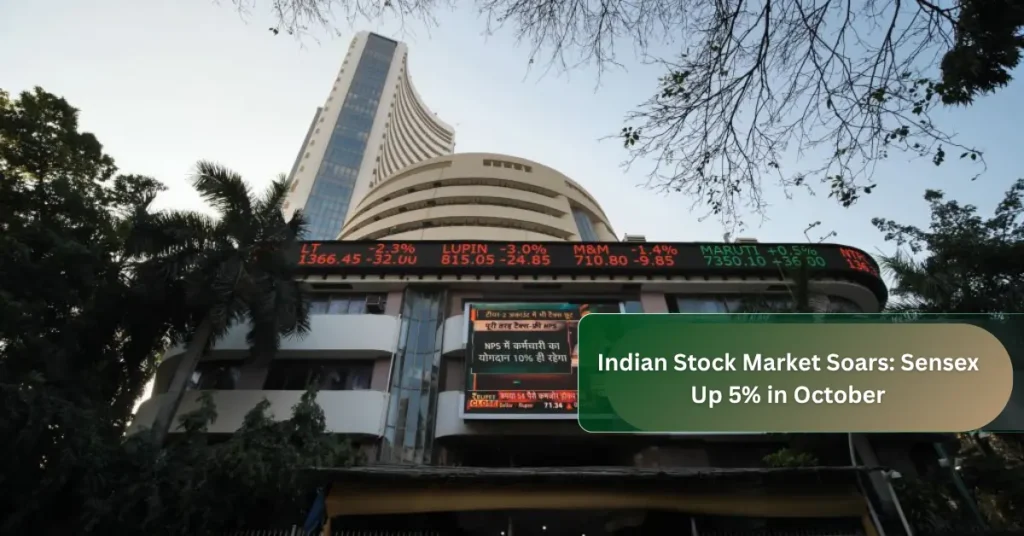Indian Stock Market: Diwali Rally Sparks Optimism for Samvat 2082
The Indian stock market has delivered a spectacular comeback in October 2025, with the Sensex surging over 4,000 points in a blistering 5% rally, driven by a dramatic turnaround in foreign institutional investor (FII) sentiment. After enduring three months of relentless foreign selling, Dalal Street is witnessing renewed optimism as FIIs pumped over ₹7,300 crore back into Indian equities during the month.
The benchmark Sensex now stands tantalizingly close to its all-time high, trailing by just 1,552 points from the 85,978 peak hit in September, while the Nifty is a mere 410 points away from its record. This remarkable recovery has market participants questioning whether the Diwali rally marks the beginning of a new bull cycle or merely a festive surge.
FII Reversal Powers Market Rally
The sharp reversal in FII flows has been the primary catalyst behind the Indian stock market’s recent strength. After selling stocks worth over ₹76,600 crore in the previous three months, foreign investors turned net buyers in October with inflows of ₹7,300 crore. The FII underweight stance on India is currently at its highest level since 2009, which several market experts believe could trigger aggressive buying if earnings recovery materializes.
Dr. Vikas Gupta, CEO & Chief Investment Strategist at OmniScience Capital, believes the Indian stock market has “probably seen the peak of pessimism and negative sentiments” and expects Samvat 2082 to show fireworks as global wars subside, interest rates decline, and trade tensions reach settlements.
Earnings Recovery Key to Sustained Rally
While the recent rally has lifted sentiment across the Indian stock market, market veterans emphasize that sustained gains depend on corporate earnings growth. Dr. VK Vijayakumar, Chief Investment Strategist at Geojit Investments Limited, points to the critical challenge: India’s earnings growth has declined sharply to 5% in FY25 from an average of 24% during the three previous years.
However, there are early signs of improvement in the Indian stock market fundamentals. Automobile and white goods sales have shot up during the early festive season, potentially lifting earnings growth to 8-10% in FY26 and accelerating to 15% in FY27. This consumption revival is expected to provide crucial support to the Indian stock market in the coming quarters.
Muhurat Trading Sets Positive Tone
The special Diwali Muhurat trading session on October 21, 2025, witnessed cautious optimism in the Indian stock market. The BSE Sensex settled at 84,426.34 levels, up 62.97 points or 0.07%, while the NSE Nifty rose 25.45 points or 0.10% to 25,868.60 levels. The symbolic one-hour trading session, held between 1:45 pm and 2:45 pm, marked the auspicious beginning of Samvat 2082.
During the Muhurat trading, largecap stocks led the gains in the Indian stock market, with Bajaj Finserv rising 1.42%, followed by Axis Bank (0.80%), Infosys (0.72%), and Tata Steel. The broader market participation was healthy, with 2,213 stocks ending with gains and only 710 closing lower on the NSE.
Market Outlook for Samvat 2082
Market experts are cautiously optimistic about the Indian stock market’s prospects for Samvat 2082. Vinit Bolinjkar, Head of Research at Ventura Securities, is targeting 27,600 for the Nifty and 90,100 for the Sensex this Samvat, implying substantial upside from current levels. He cites a revival in domestic consumption-driven earnings from Q3FY26, a potential US-India trade deal, and continued fiscal and monetary support as key drivers for the Indian stock market.
The Nifty currently trades at a CY26 forward P/E of 18x, only marginally above its long-term average of 17x, suggesting that the potential for further downside is limited. A Balasubramanian, MD & CEO of Aditya Birla Sun Life AMC, expects returns of 10-12% from Diwali to Diwali, “much higher than muted returns in Samvat 2081,” with gains likely led by consumption growth, credit growth pickup due to RBI rate cuts, and positive tariff negotiation outcomes.
Sectoral Performance and Investment Strategy
The October rally in the Indian stock market has remained largely concentrated in frontline stocks and institutional favorites, with Nifty Bank surging over 6% during the month, while midcap and smallcap indices posted modest 3-4% gains. This suggests that the broader market is still catching its breath after the recent correction.
For the Indian stock market in Samvat 2082, analysts recommend a buy-on-dips approach, focusing on large-cap sectors like banking, FMCG, and automobiles, which show strong earnings visibility. Banking, healthcare, and consumption-focused sectors are expected to lead market gains. Traders should remain selective in smallcaps and monitor global cues closely, particularly updates on US-China trade talks and inflation expectations, which will shape foreign investor flows.
The Indian stock market’s technical setup remains positive as long as Nifty stays above 25,700, below which it may move back into consolidation. Immediate resistance for the Indian stock market lies around 26,000-26,200 in the short term.
Keywords: Indian stock market, Sensex, Nifty, FII flows, Samvat 2082, Muhurat trading, stock market rally, earnings growth, investment strategy, banking stocks
Hashtags: #IndianStockMarket #Sensex #Nifty #DiwaliRally #Samvat2082 #FIIFlows #StockMarketIndia #InvestingIndia #MuhuratTrading #DalalStreet
Standard Disclaimer
This article is for educational purposes only and should not be considered as investment advice. The Indian stock market is subject to market risks, and investors should conduct their own research or consult with a qualified financial advisor before making any investment decisions. Past performance is not indicative of future results.

